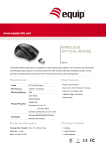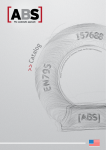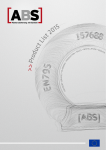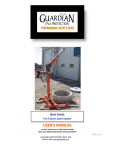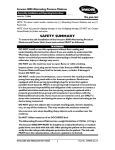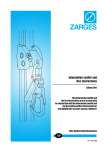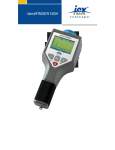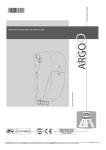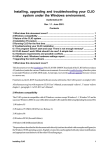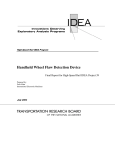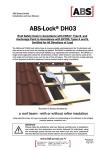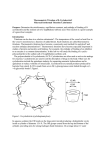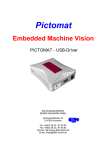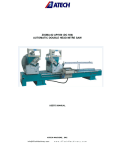Download PDF ABS Safety Manual
Transcript
The systematic approach Safety Instructions MoA-178-01 | 14.04.2015 INSPECTION LOG Installer Installation Date Place Date of entry into service Model description, standard Batch or serial number Date Processing reason (routine examination or maintenance) Discovered damage, maintenance work carried out, remove from service and replace etc. -2- Name and signature of the examiner/expert Next inspection USA Thank You... Warnings and Limitations: ... for your purchase of ABS Safety fall protection equipment. ABS Safety products are produced to meet the highest standards using the latest manufacturing technology. • This ABS fall protection system complies with ANSI and OSHA. • Before installing an anchorage connector, carefully inspect it to ensure that it is in a useable condition. Check for missing or damaged parts. Do not use this equipment if any of the components are not operating properly or if the unit appears to be damaged in any way. Please also refer to the inspection section of this manual. • Only trained or competent personal should install and use this equipment. • Ensure that the anchorage connector is installed at a height that limits the free fall distance to 6 ft. (1.8m) or less. • The anchorage connector must be compatible with the snap hook or carabiner of the connecting device. It must not allow a load to be applied to the gate/keeper. • Never use an anchorage connector which prevents the snap hook or carabiner gate/keeper from closing. • This anchorage connector is designed for use by one person with a total weight, including tools, of no more than 310 lbs. (140.6 kg) if following ANSI Z.395 requirements and • 420 lbs.(190.5 kg) if following OSHA requirements– do not exceed this weight limit. • There must be sufficient clearance below the user to arrest a fall before the user strikes the ground or other obstructions. WARNING All persons using this equipment must read and fully understand all the instructions provided both in the instruction manual and in this supplement - or have them explained to them. Failure to comply may results in serious injury or death. Do NOT use this equipment unless properly trained. Questions? Call 1-800-485-1285 This manual is intended to comply with the manufacturer’s instructions as required by ANSI Z359.1 and should be used as part of an employee training program as recommended by OSHA. It is crucial that the person/ user of this fall protection equipment reads and fully understands these instructions. In addition, it is the employer´s responsibility to ensure that all users are trained in the proper use, inspection, and maintenance of fall protection systems. Fall protection should be a part of a comprehensive safety programm. Proper use of fall arrest systems can save lifes and reduce the potential of serious injuries from a fall. The user needs to be aware that forces experienced during the arrest of a fall or prolonged suspension may cause bodily injury. Requirements, Warnings and Limitations General Requirements: • All warnings and instructions shall be provided to authorized persons/ users. Warnings and instructions must be read and understood prior to using this equipment. • Accurate preparation of the working site is necessary. Remove any obstructions, debris, material, or other recognized hazards from the work area that could cause injuries or interfere with the operation of the system. • All equipment must be inspected before each use according to the manufacturer´s instructions. • All equipment should be inspected by a qualified person on a regular basis. • To minimize the potential for accidental disengagement, a competent person must ensure system compability. • This system is designed as an attachment point for a personal fall arrest system to protect the user in the event of a fall. Fall arrest systems typically include a full body harness and a connecting subsystem (energyabsorbing lanyard, self retracting lifeline). • As required by OSHA, the personal fall arrest system must be capable of arresting the user’s fall with a maximum arresting force of 1,800 lbs. (8kN), and limit the free fall to 6 feet (1.8m) or less. • Never remove product labels as these include important warnings and information for authorized persons/users. • Any equipment that has been subjected to damage, or where force has been asserted through arresting a fall or affecting a rescue, must be removed from service, as specified by the manufacturer. • Use only locking carabiners or snap hooks with min. 3,600 lbs. (16kN) gate load capacity inline with ANSI Z359.1(07) and OSHA. • The user shall have a rescue plan and the means at hand to implement it when using this equipment. System Compatibility: • ABS Safety systems are designed for use with ABS Safety approved components. Substitution or replacement with non-approved component combinations, sub-systems, or both, may affect or interfere with the safe function of each other and risk the compatibility within the system. This incompatibility may affect the reliability and safety of the total system. ABS Safety requires the use of system compatible body wear. If you are in doubt please contact ABS Safety´s support 1-800-485-1285. In any way, all instructions and warnings provided with the equipment must be read and understood before using the equipment. Capacity: • Maximum capacity for single point anchors is one user at a maximum 310lbs (140.6 kg) ANSI Z359 and 420 lbs according to OSHA, combined tool, clothing and body weight. • When used as a component within an approved ABS Safety horizontal lifeline system, the lifeline system capacities apply. Free Fall: • Personal fall arrest systems must be rigged to limit a free fall to the shortest possible distance [6 ft (1.8 m) maximum]. • Situations where the 6 ft (1.8 m) will be exceeded, a compatible lanyard with a shock absorber pack must be used to keep the fall arrest forces at or below 1,800 lbs (8 kN). Free fall must never exceed 12 ft (3.7 m). All standards requirements for a free fall exceeding 6 ft (1.8 m) must be met. Deformation of the System: • ABS Safety´s fall protection systems are uniquely engineered. Most of the system´s are energy absorbing, minimizing the forces imposed on the user and the structure. Fall Clearance: • Ensure that the adequate clearance exists in the potential fall path to avoid striking a lower level or other objects. The potential for a pendulum fall must be minimized. An extra of 2 ft (0.6 m) of fall clearance needs to be added to the calculation to account for the energy absorbing system. Anchorage Requirements: Structural requirements: • An anchorage and anchorage connector selected for a fall arrest system should be capable of sustaining a static load of at least twice the maximum arrest force permitted on the system where certification exists, or 5,000 lbs. (22.2kN) in the absence of certification. • An anchorage connector must not be anchored where such attachment would reduce the anchorage capacity to below the applicable level. • The structure that the safety system is installed to must be capable of supporting a 5,000 lbs (22.2 kN) static load in the direction of loading or meet OSHA requirements for a safety factor of two. Environmental Hazards: • Use of this equipment in areas where environmental hazards exist may require additional precautions to limit the possibility of injury to -3- USA the user or damage to the equipment. Hazards may include, but are not limited to, extreme temperatures, caustic chemicals, corrosive environments, high voltage power lines, explosive or toxic gases, moving machinery, and sharp edges. Do not expose the equipment to any hazard which it is not designed to withstand. Inspection, Maintenance and Training Inspection: • ABS Safety systems are designed for today´s rugged work environments. To maintain their service life and high performance, all components should be inspected frequently. Anchorage connectors must be visually inspected by the user before each use and inspected by a competent person on a regular basis. Replace equipment if any of the defective conditions explained in this manual are found. • Inspect the system for any of the following: bent, cracked, disorted, worn, malfunctioning or damaged parts; loose fasteners or missing parts/ components; deteriortion; deformation; corrosion; signs that indicate the product has been subjected to a fall arrest; or any other indications of damage/ problems that may affect the integrity and operation of the product. If in doubt contact ABS Safety. • Check if all components are attached securly to each other and the roofs surface and does not show any damage as listed above. • Check all fasteners and corrosponding torque values to ensure that it is still meets all anchorage requirements. • Inspect the condition of the roof to ensure that it still meets all anchorage requirements. • Inspect the components of the personal fall arrest system according to the manufacturer´s instructions. • ABS Safety´s roof anchors should always be in upright position. If the anchor has been subjected to fall arrest forces the post will be tipped over in the direction of loading. System Requirements: Compatibility of Components: ABS Safety equipment is designed for use with ABS Safety approved subsystems and components only. Substitutions or replacements made with non-approved components or subsystems may jeopardize compability of equipment and may effect the safety and reliability of the complete system. Compatibility of Connectors: Connectors are considered to be compatible with connecting elements when they have been designed to work together in such a way that their sizes and shapes do not cause their gate mechanism to inadvertently open regardless of how they become oriented. Contact ABS Safety if you have any questions about compability. Connectors (hooks, carabiners, and D-rings) must be capable of supporting at least 5,000 lbs. (22.2 kN). Connectors must be compatible with the anchorage or other system components. Do not use equipment that is not compatible. Non-compatible connectors may unintentionally disengage. Connectors must be compatible in size, shape and strength. Self-locking snap hooks and carabiners are required by ANSI Z359.1 and OSHA. Making Connections: Use only self-locking snap hooks and carabiners with this equipment. Use only connectors that are suitable to each application. Ensure all connections are compatible in size, shape and strength. Do not use equipment that is not compatible. Ensure all connectors are fully closed and locked. Devices that do not pass inspection or have been subjected to fall arresting forces must be removed from service. Frequency: Unintentional Disengagement (Roll-out) If the connecting element that a snap hock (shown) or carabiner attaches to is undersized or irregular in shape, a Situation could occur where the connecting element applies a force to the gate of the snap hock or carabiner. This force may cause the gate (of either a self- locking or a non-locking snaphock) to open, allowing the snap hock or carabiner to disengage from the connecting point. • Before each use: Inspect ABS Safety equipment according to the points above. • Annually: A formal inspection of ABS Safety equipment and its connection to the structure must be performed at least annually by a competent person other than the user. The frequency of formal inspections should be based on conditions of use or exposure. 1. Force is applied to the snap hook. (Small ring or other noncompatibility conector) Cleaning and Storage: 2. The gate presses against the connecting ring. • Basic care of ABS Safety Equipment will prolong the life of the unit and will contribute toward the performance of its vital safety function. Servicing: • Servicing of ABS Safety equipment must only be carried out by ABS Safety or persons/ entities authorized in writing by ABS Safety. A record log of all servicing and inspection dates for this device must be maintained. Only original ABS Safety replacement parts are approved for use in ABS Safety equipment. Non-repairable devices that do not pass inspection must be disposed of in a manner to prevent inadvertent further use. • Contact ABS Safety Technical Services at 1-800-485-1285 if you have any questions. Training: • It is the responsibility of the user and the purchaser of this equipment to assure that they are familiar with these instructions, trained in the correct care and use of, and are aware of the operating characteristics, application limits, and the consequences of improper use of this equipment. Important: Training must be conducted without exposing the user to a fall hazard. Training should be repeated on a periodic basis. -4- 3. The gate opens allowing t he snap hook to slip off. Inappropriate Connections USA Additional Requirements for Lifeline Systems: • All warnings and instructions shall be provided to authorized persons/ users. Warnings and instructions must be read and understood prior to using this equipment. • All authorized persons/ users must reference the regulations governing occupational health and safety, as well as applicable standards. ABS Lock SYS I-II meet OSHA and ANSI. • Proper precautions should always be taken to remove any obstructions, debris, material, or other recognized hazards from the work area that could cause injuries or interfere with the operation of the system. • All equipment must be inspected before each use according to the manufacturer´s instructions. • All equipment should be inspected by a qualified person at least once a year. • To minimize the potential for accidental disengagement, a competent person must ensure system compability. • Equipment must not be altered in any way. Repair must be performed only by the equipment manufacturer, or persons or entities authorized, in writing, by the manufacturer. • Any product exhibiting defomities, unusual wear, or deterioration must be immediately discarded. • The user shall have a rescue plan and the means at hand to implement it when using the equipment. • Never use fall protection equipment for purpose other than those for which it was designed. Fall protection equipment should never be used for towing or hoisting. • Never remove product lables, which include important warnings and information for the authorized person/ user. Certification: The ABS-Lock® SYS fall protection system meets and exceeds the requiremenst set by ANSI/ OSHA, for up to 10 individuals - depending on the model and type of installation - and complies with the requirements set by the industrial employers´ liability insurance associations. ABS-Lock® SYS I for up to 10 individuals simultaneously ABS-Lock® SYS II for up to 10 individuals simultaneously • Do not expose the anchorage connector to chemicals or other aggressive substances. If in doubt please contact the manufacturer. • If there are any doubts as to the safety of the system it should be immediately taken out of service and sent to the manufacturer for inspection. Users: The ABS-Lock® SYS system was developed to protect individuals from falls whilst working. In the case of a fall the force exerted on the user is reduced to what medical experts view as an acceptable level. Only individuals who are familiar with the user manual and are phisically healthy may use the system. If there are any doubts regarding the users´phisical condition, please consult a doctor prior to usage. Children and pregnant women should not use the system. IMPORTANT: When used as a restraint system with a rope grab device, the lanyard must be setup in such a way as to make a fall impossible. ABS does not accept any liability for non-conformance! Orderly Conditions: System Checks The equipment owner and/ or user must always visually check the personal fall arrest protection equipment prior to usage to ensure that it is in orderly condition and functions properly. The employer must have personal fall arrest protection equipment checked by a qualified person as required by the respective implementation and operating conditions - at least once a year - to ensure it is in perfect condition. Often it is not possible to examine the whole system before the user attaches himself/ herself to it. However, should damage, corrosion, deformation etc. be clearly visible, the system must not be used. Examination Prior to Usage Inspection (prior to usage): The recommendations for the usage of other products in conjuction with this system must be observed. All system components must be free from damage with no evidence of corrosion. The concrete where the end and intermediate brackets are installed must be unflawed and have no obvious cracks. The system must be in good working order without any wear, tear or deformation. The system must not be used if the above criteria are not fulfilled. In accordance with OSHA the ABS-Lock® SYS system must be checked by a competent person prior to usage - and at least once a year - to ensure that it is in orderly condition. In exceptional circumstances - depending on the type of implementation - further examinations may be required. Safety Harness and Lanyard Examinations Examine your safety harness, lanyard and hook according to the user manuals. Onn any account, do not use the equipment if there are signs of damage or if they have been subjected to fall conditions. Cable Glider Examination (only SYS II) Prior to usage examine the SYS II gliders for signs of wear, damage or corrosion. Confirm that the carabineer hook is attached correctly and is firmly closed. Only use the glider in combination with the original carabineer and your SYS II fall protection cabling system. The system must be subjected to an ANNUAL inspection by an authorized technician which is to be documented accordingly. This examination is important as the effectiveness and durability of the system is dependent upon it - and consequently the user´s safety. Calculation of Cable Deflection and Load in the Case of a Fall Scenario: Safety Regulations: • Never use the system for transporting/ hoisting materials. • Wherever possible do not work above the anchorage point (please refer to the lanyard operating manual). • The ABS system specification plate provides information on the maximum number of simultaneous users. • This product may only be used by appropriately instructed and trained personnel. • This product must be used with connectors (in accordance with ANSI/ OSHA) and personal fall protection equipment (e.g. lanyard with force absorber according to ANSI/ OSHA, guided type fall arrester with a flexible anchor in compliance with ANSI/ OSHA or a self-retracting lifeline in accordance with ANSI/ OSHA). • Following a fall the product must be taken out of service and replaced by a licensed ABS contractor. Calculation Examples: Cable deflection/load - calculated for 4 individuals without force absobtion Distances between the supports 40 ft. (12 m), total cable length 329 ft. (100 m). In the case of a fall of 4 individuals this results in 53 in. (134 cm) cable deflection and maximum load of 3260 lbf (14.5 kN) at the terminal connections. Additionally, the manufacturer´s guidelines regarding the respective fall arrest system in accordance with ANSI/ OSHA must be incorporated in the calculations. Reducing the number of individuals or usage as a restraint system can greatly reduce cable deflection and load at the teminal points. -5- USA Examples of cable sag in different system set-ups: 131 ft (40 m) straight run on a concrete substructure using 12 in (300 mm) high posts with a post distance of 32.8 ft (10 m): in this case the cable sag would be 7.28 ft (2.22 m) 131 ft (40 m) straight run on a rigid steel substructure along a wall using anchors without protrusion with a post distance of 32.8 ft (10 m) and one force absorber to 8 kN: in this case the cable sag would be 8.08 ft (2.46 m) 131 ft (40 m) straight overhead run on a concrete substructure anchors without protrusion with a post distance of 32.8 ft (10 m) and one force absorber to 8 kN: in this case the cable sag would be 8.08 ft (2.46 m) IMPORTANT: Please always consider the possible fall distance! ABS Safety Inc. always recommends that a 3 ft. (1.0 m) safety factor be added to all fall clearance calculations. Distance Between Posts in an ABS Lock SYS I-II: Structure Concrete Solid Steel Construction Trapezoidal Sheeting Sandwich Sheeting Seam Roof Wood Construction (Beams/ Casing) Prestressed Suspended Concrete Ceilings Distance between posts 26 - 40 ft. (8 - 12 m) 26 - 40 ft. (8 - 12 m) 23 - 26 ft. (7 - 8 m) 23 - 26 ft. (7 - 8 m) 23 - 26 ft. (7 - 8 m) 23 - 26 ft. (7 - 8 m) 23 - 30 ft. (7 - 9 m) Calculation: User approx. 6 ft. (180 cm) + Manufacturer´s information for your fall arrest system acc. to ANSI/ OSHA + Change in the length of the cabling system following a fall + Additional safety reserve at least 40 in. (1 m). ______________________________________________________ = possible fall distance Distance between the supports 50 - 66 ft. (15 - 20 m): Generally it is possible to place the supports up to 66 ft. (20 m) apart. However, this only makes sense in exceptional circumstances. If required please contact ABS Safety. -6- USA CALCULATION OF FALL CLEARANCE Example 1 Force Absorber + Lanyard ~ 60 in. (1.5 m) Self-retracting-lifeline ~ 20 in. (0.5 m) System Deflection according to table 1 ~ 20 - 99 in. (0.5 – 2.5 m) Safety Distance 40 in (1 m) Example 2 (Restraint System) Example 3 (Fall Arrest System) ≥ 2,5 m No Fall Clearance needed due to worker restraint. Standing Disctance + lanyard ~ 8 ft. (2 m) Force Absorber with PPE ~ 60 in. (1,5 m) Self-retracting-lifeline ~ 20 in. (0,5 - 2 m) Individual´s Height ~ 71 in. (1,8 m) System Strech according to Table 1 ~ 20 - 99 in. (0,5 – 2,5 m) Safety Disctance 40 in. (1 m) -7- USA Calcualation of Fall Clearance EXAMPLE: Ground Disctance between posts Concrete 26 - 40 ft. (8 - 12 m) Solid Steel Construction 26 - 40 ft. (8 - 12 m) Trapezoidal Sheeting 23 - 26 ft. (7 - 8 m) Sandwich Sheeting 23 - 26 ft. (7 - 8 m) Seam Roof 23 - 26 ft. (7 - 8 m) Wood Construction (Beams/ Casing) 23 - 26 ft. (7 - 8 m) Prestressed Suspended Concrete Ceilings 23 - 30 ft. (7 - 9 m) Gas Concrete 23 - 26 ft. (7 - 8 m) Personal Fall Arrest System Connectors: Connectors used to attach to the attachment eyelet or the horizontal lifeline (hooks, carabineers, Drings) must support at least 5,000 lbf (22.2 kN). Anchorage Connector: Connectors used to attach the horizontal lifeline to end anchors must be compatible with the connection point. The connection must be positive; and with connection elements, capable of sustaining 5,000 lbf (22.2 kN). Calculation: User approx. 71 in. (180 cm) + Manufacturer´s information for your fall arrest system acc. to ANSI/ OSHA + Change in the length of the cabling system following a fall (pls. refer to Tab.1 on Page 10) + Additional safety reserve at least 40 in. (1 m). ______________________________________________________ = In some situations the user may hold onto the cable for safety reasons. This is permissible but care should be taken to ensure that not too much pressure is used as this could lead to deformation of the system. The system is specially designed to buckle under stress to protect the supporting structure and the user from being subjected to exessive force when put under pressure (when someone falls). Structure Load: Structural anchorage points must be rigid, and capable of supporting at least 5,000 lbf (22.2 kN) along the axis of the horizontal lifeline system, unless designed by a qualified person. Anchorages must also support at least 3,600 lbf (16 kN) applied in all potential direction of fall arrest that are perpendicular to the axis of the horizontal lifeline system, unless designed by a qualified person. possible fall distance Distance between the supports 50 - 66 ft. (15 - 20 m): Generally it is possible to place the supports up to 66 ft. (20 m) apart. However, this only makes sense in exceptional circumstances. If required and needed for calculations using Table 1 pls. contact ABS Safety. Application: ABS-Lock® SYS was developed to provide the user with the greatest possible freedom of movement. During normal usage the carabineer smoothly glides over the streches between the supports whilst the user moves along (SYS I). SYS II glides over. Connecting Subsystems: The connecting subsystem is the portion of the personal fall arrest system that is used to connect between the horizontal lifeline subsystem and harness fall arrest attachment element. The connecting subsystem must limit forces applied to the horizontal lifeline to 1,800 lbf (8kN) or less. Putting On and Securing a Lanyard/ Safety Harness: Please refer to the corrosponding product manuals. -8- USA KEY TO SYMBOLS i i i ! User and Installation Manual Round brush (wire bristles) Required rivet type Please observe the User and Installation Manual Air pump Safety Manual Adjustable torque wrench Please observe the Safety Manual! Torque wrench with bit Insert manually Please use personal protective fall equipment! Required jaw width Sealant/ thread lock Correct usage Please observe the cement instructions! Screwdriver Apply sealant/ thread lock Wrong usage Tools Vacuum cleaner Cordless screwdriver Blowtorch Clean drill hole: Brush and blow out Electric drill Plastic mallet Concrete adhesive BLINDNIETE BLIND RIVET 5,2 x 19,1 mm 3-4x Hex key xxx mm Optional components not included in the original package. These can be purchased from and supplied by ABS. 6 mm max 1 Maximum number of simultaneous users per anchorage system 1/3 PSA i M20 Tap a thread, No.: Tap size ! C 20/25 B 25 Only install in concrete of illustrated quality Steel installation Hexagonal nut, No. = Diameter Hot-air gun Permissible force uptake: Lateral Installation on wood Torx-Bit Angle grinder Permissible force uptake: Axial Installation on bitumen Torque wrench No. = jaw width Wire cutter Permissible force uptake: Lateral, both directions Installation on PVC Torque wrench + countered Hand riveter The drying time stated in the cement instructions must be strictly observed! Counterweighted with gravel Spanner No. = jaw width Hand riveter with rivet User a hammer Folding ruler T25 24 ft. lbs. Warning Permissible force uptake: Axial and lateral 8 mm Nm Important Rubber mallet 24 mm ft. lbs. Amount of cement to be used, No. = filling level Drill bit, No. = Diameter MATERIAL Nm No. of rotations No. = number 32 Rounded-edge seam i 24 70 Nm 52 lbf ft -9- Tightening torque to be used, No. = torque Standing seam USA KEY TO SYMBOLS Kliptec, Snap seam Lateral battens 280-333 mm 160-250 mm Counter lathing Distance from the center of two adjacent beads, cold roof Do not put your full weight on the rain gutter. The LaddQuick is designed to prevent tipping Distance from the center of two adjacent beads, warm roof Min. space for opening the toggle bolt min 0,5 mm Rafter insulation Min. thickness of trapez. sheeting material Concrete adhesive: For overhead installation fix the anchor with wedges +5°C +25°C Audible acoustic click CLICK 120mm Moist substructure ABS LaddFix: Do not lean ladder against the rain gutter min 60 mm Roof beam/rafter 10 cm Concrete adhesive: Do not use first 10 cm of adhesive Concrete adhesive: Store cool and dry Do not put your full weight on the rain gutter. The LaddFix is designed to prevent tipping Restraint system Use in temperatures of - to Sharp-edge tested, r=Radius Min. roof beam/ rafter dimensions Mark drilling spot Material thickness Shake well Min. installation depth Material can be bent max. 5x. Do not bend more than 5x Action of heat Width/distance Applied Load Action of cold Distance to the edge of the structure Min. inside ladder width Maximum angle of inclination Fall protection 60mm °C min 6 mm r=0,5 mm MAX max 5x min. 100 cm X mm min. 85 mm Max. x mm max 3° Maximum gap Min. inside ladder width Consult ABS Safety Inc. Cable diameter Secured using ladder safety device To be used as an end-post in a HLL Trapezoidal sheeting cold roof Danger of falling without ladder safety device To be used as a corner-post in a HLL Trapezoidal sheeting warm roof ABS LaddQuick: Do not lean ladder against the rain gutter To be used as a single point anchor 8 mm min 20 mm min 10 mm Trapez. sheeting: Min. raised bead width Trapez. sheeting: Min. distance betw. bore hole and bead edge To be used in a HLL Please observe - 10 - Concrete adhesive: Dispose Cap Temporary anchor SCRIBBLES & NOTES - 11 - The systematic approach ABS Safety GmbH Gewerbering 3 D-47623 Kevelaer Germany Tel.: +49 (0) 28 32 - 972 81 - 0 Fax.: +49 (0) 28 32 - 972 81 - 29 www.absturzsicherung.de www.fall-arrest.eu ABS Safety Inc. 2220 Northmont Parkway, Suite 250 Duluth, GA 30096 U.S.A. Rh ein s Phone: 1-800-485-1285 Fax.: 1-678-417-6273 www.abs-fall-protection.com e L49 1 Niers raß Ho ew t pa ß str se n eg d In t us rie e Gew ring rt Stra ley nde hs Do t ra ge ld ße Ge er tra rS ne te Al ße ra st er ße He 91 L4 Str aße K3 0 erbe ner Köl He S e aß str en e ner ße n on ß ra rs tra st We tte e raß Bosc h s t Röm e LP 2. Juni 2015 f aß 9 str Ho g we en ex Ho ew og e aß de ho hn Ba La ld Fe Am Alte Wettener Straß e en nk he Sc Os ße Am KEVELAER eg ra kastra Ba hn s Basili ße Jäg ers t og












